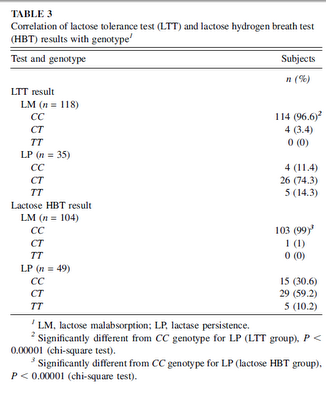|
Sunday, January 24, 2010
Frequency of lactose malabsorption among healthy southern and northern Indian populations by genetic analysis and lactose hydrogen breath and tolerance tests:
Volunteers from southern and northern India were comparable in age and sex. The LTT result was abnormal in 88.2% of southern Indians and in 66.2% of northern Indians...The lactose HBT result was abnormal in 78.9% of southern Indians and in 57.1% of northern Indians...The CC genotype was present in 86.8% and 67.5%...the CT genotype was present in 13.2% and 26.0%...and the TT genotype was present in 0% and 6.5%..of southern and northern Indians, respectively. The frequency of symptoms after the lactose load...and peak concentrations of breath hydrogen...both of which might indicate the degree of lactase deficiency, were higher in southern than in northern Indians.  The north Indian samples were from Lucknow on the mid-Gangetic plain, and the south Indian samples from Bangalore. The genetic variant conferring lactase persistence is the Central Asian one, T-1390. You can see the distribution of the genotypes by phenotype in the table to the left. These authors assume that the T allele was brought by the Indo-Aryans; this seems plausible seeing its clinal variation, as well the fact that this variant seems to be common in European and Central Asian populations. The frequency of the T allele in the Lucknow sample was 39%, and 13% in the Bangalore sample. Here are a selection of frequencies for the T allele in other populations: The north Indian samples were from Lucknow on the mid-Gangetic plain, and the south Indian samples from Bangalore. The genetic variant conferring lactase persistence is the Central Asian one, T-1390. You can see the distribution of the genotypes by phenotype in the table to the left. These authors assume that the T allele was brought by the Indo-Aryans; this seems plausible seeing its clinal variation, as well the fact that this variant seems to be common in European and Central Asian populations. The frequency of the T allele in the Lucknow sample was 39%, and 13% in the Bangalore sample. Here are a selection of frequencies for the T allele in other populations:17% - Saami You can see more here. This looks like a case of local adaptation. Labels: India, Population genetics |



